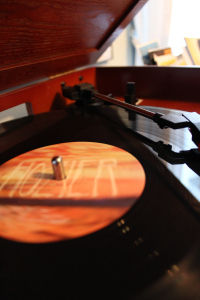Vinyl: Hozier
- Kris
- Feb 10, 2015
- 3 min read
Honey, you’re familiar like my mirror years ago Idealism sits in prison, chivalry fell on its sword Innocence died screaming, honey,
Ask me I should know I slithered here from Eden
Just to sit outside your door.
Hozier –“From Eden”
Hozier
Disk 1 – Side A: Take Me to Church, Angel of Small Death & The Codeine Scene, Jackie and Wilson
Disk 1- Side B: Someone New, To Be Alone, From Eden
Disk 2- Side C: In a Week (feat. Karen Cowley), Sedated, Work Song
Disk 2 – Side D: Like Real People Do, It Will Come Back, Foreigner’s God, Cherry Wine (Live)
Joined collection: From Boyfriend for Xmas gift
I’m gonna go out on a limb here and assume you’ve heard “Take Me to Church” – if not on the radio, then when Hozier performed on SNL last October or recently with Annie Lennox at the 2015 Grammys. If you haven’t seen the music video accompanying the hit song, you should. The music video vividly and powerfully follows the story of two men in a relationship who suffer at the cruel hands of prejudice.
Andrew Hozier-Byrne encourages his audience to interpret and explore what his music means for them. One could probably argue that ‘Take Me to Church” is an anti-religious song, but that’s not completely it in my opinion. What it does do is discuss hypocrisy and morality, while also celebrating natural emotions and passions. It does not reject the idea of worship, but rather explores how we worship and asks us to examine what we believe in and where we place our devotion.
It is the first single from Hozier’s self-titled album, and already some of the other tunes have made their way to the radio. If you’ve heard “Take Me to Church” and not yet explored Hozier’s other songs, now is the time to do so. The rest of the album, following the traditions of blues, soul, gospel, and folk, explores similar themes with the same resonance and meaningful articulation. Hozier is a master of imagery and the written word; each lyric is a line of poetry in close conversation with the writers and literature that came before him. “Angel of Small Death & the Codeine Scene” Hozier says was heavily inspired by James Joyce’s Portrait of the Artist as a Young Man, and it also unabashedly explores sexuality.

He explores beautiful sensations in spite of harsh environments and situations, which is characteristic of Irish writing. I think distinctly of “In a Week,” which uses decomposition of corpses as a form of connecting people with the Earth and with each other. It is both romantic and foul in its honesty. This juxtaposition can be found throughout the album.
Despite the thematic ties, though, each song has its own moments and tells a different kind of story.
“Jackie and Wilson” describes young man who has a one-night-stand with a woman and conjures a future for himself and their children. Even though he knows it’ll only last the night, he creates an idyllic world and imagines what their story could be. The song discusses idealism and escapism. This is one of the more fun songs on the album, but the positivity of the speaker’s escape in this track contrasts with the later themes in “Sedated” which explores the twisted ways we seek to lose ourselves.
“Like Real People Do” is a story about a being who is drawn from the Earth to become the digger’s lover. And though he wonders what darkness lies behind the reason the digger was there in the first place, he does not ask. Instead, he figures he should kiss the doubts away. What drew me to this song was the more broad interpretation that the lovers both have dirty or ugly pasts of which they do not speak, yet they feel a connection with each other despite this. The speaker’s feelings are in motion. The memories are still present, and doubt lingers in the speaker’s thoughts. The act of kissing emphasizes the journey to leave these things behind, but is not a safe-haven or a sudden resolution.
And the ‘cherry wine’ in the final track is actually the blood of lovers, whose relationship is violent and controlling. Despite this, the speaker wants the special way she loves, wants her, as “it’s a crime that she’s not around most of the time.” This closing song is recorded live and outside with the birds chirping in the background, stripped down to the most essential elements of Hozier’s music – his guitar and his voice.
Hozier’s music reveals new truths and complexities with every listen. The way he writes, often by creating a character or perspective close – but not identical – to his own voice, results in a strong narrative to his songs. The personalities are relatable, but flawed. And inevitably he motivates us to look internally at ourselves and the ways in which we love, hurt, and dream.

Comments